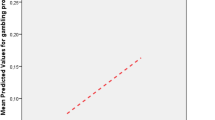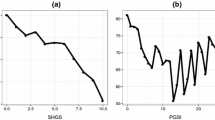Abstract
Most states and territories in Australia have adopted the Problem Gambling Severity Index (PGSI) of the Canadian Problem Gambling Index as the standard measure of problem gambling in their prevalence studies and research programs. However, notwithstanding this attempted standardisation, differences in sampling and recruitment methodologies and in some cases the modification of the scoring methods used in the PGSI have lead to substantial difficulties in comparison of the prevalence rates obtained in different studies. This paper focuses on how these two actions may significantly underestimate the true prevalence percent of problem gambling in Australian studies of the prevalence of problem gambling. It is recommended that the original and validated version of the PGSI is used in future Australian prevalence studies and that prevalence in community studies is studied across the whole community not arbitrarily restricted sub-samples. The adoption of valid scoring methods and unbiased sampling procedures will lead to more accurate and comparable prevalence studies.
Similar content being viewed by others
References
Abbott, M. W., & Volberg, R. A. (2006). The measurement of adult problem and pathological gambling. International Gambling Studies, 6(2), 175–200.
AC Nielson. (2007). Prevalence of gambling and problem gambling in New South Wales. Sydney: NSW Office of Liquor, Gaming and Racing.
Arthur, D., Tong, W. L., Chen, C. P., Ai, Y. H., Sagara-Rosemeyer, M., Kua, E. H., et al. (2008). The validity and reliability of four measures of gambling behaviour in a sample of Singapore university students. Journal of Gambling Studies, 24, 441–450.
Battersby, M. W., Thomas, L., Tolchard, B., & Esterman, A. (2002). The South Oaks Gambling Screen: a review with reference to Australian use. Journal of Gambling Studies, 18, 257–271.
Brown, D., Patton, D., Dhaliwal, J., Pankratz, C., & Broszeit, B. (2002). Gambling involvement and problem gambling in Manitoba. Winnipeg: Addictions Foundation of Manitoba.
Cox, B. J., Yu, N., Afifi, T. O., & Ladouceur, R. (2005). A national survey of gambling problems in Canada. Canadian Journal of Psychiatry, 50, 213–217.
Doiron, J. (2006). Gambling and problem gambling in Prince Edward Island. Submitted to Prince Edward Island Department of Health.
Ferris, J., & Wynne, H. J. (2001a). The Canadian Problem Gambling Index. Ottawa: Canadian Centre on Substance Abuse.
Ferris, J., & Wynne, H. J. (2001b). The Canadian Problem Gambling Index: Users manual. Ottawa: Canadian Centre on Substance Abuse.
Gambino, B., & Lesieur, H. (2006). The South Oaks Gambling Screen (SOGS): a rebuttal to critics. Journal of Gambling Issues, 17. Available: http://www.camh.net/egambling/issue17.
Gambling Policy Directorate and Office of the Government Statistician. (2002). Queensland gambling household survey, 2001. Brisbane: Queensland Treasury.
Gambling Policy Directorate and Office of the Government Statistician. (2006). Queensland gambling household survey, 2003–04. Brisbane: Queensland Treasury.
Gambling Policy Directorate and Office of the Government Statistician. (2008). Queensland gambling household survey, 2006–07. Brisbane: Queensland Treasury.
Govini, R., Frisch, G. R., & Stinchfield, R. (2001). A critical review of screening and assessment instruments for problem gambling. Windsor: Problem Gambling Research Group, University of Windsor.
Holtgraves, T. (2009). Evaluating the problem gambling severity index. Journal of Gambling Studies, 25, 105–120.
Ipsos-Reid and Gemini Research. (2003). British Columbia problem gambling prevalence study. British Columbia: Ministry of Public Safety and Solicitor General.
Ipsos-Reid Public Affairs and Gemini Research. (2008). British Columbia problem gambling prevalence study: Final report. British Columbia: Ministry of Public Safety and Solicitor General.
Lemaire, J., MacKay, T., & Patton, D. (2008). Manitoba gambling and problem gambling 2006. Winnipeg: Addictions Foundation of Manitoba.
Lesieur, H. R., & Blume, S. B. (1987). The South Oaks Gambling Screen (SOGS): a new instrument for the identification of pathological gamblers. American Journal of Psychiatry, 144, 1184–1188.
Market Quest Research. (2009). 2009 Newfoundland and Labrador gambling prevalence study. Prepared for the Department of Health and Community Services. St. John’s: Government of Newfoundland and Labrador.
Market Quest Research Group Inc. (2005). 2005 Newfoundland and Labrador gambling prevalence study. Prepared for the Department of Health and Community Services. St. John’s: Government of Newfoundland and Labrador.
Marshall, K., & Wynne, H. (2003). Fighting the odds: Perspectives on labour and income. 4(12), Statistics Canada Catalogue no. 75-001-XIE.
McCready, J., & Adlaf, E. (2006). Performance and enhancement of the Canadian Problem Gambling Index (CPGI): Report and recommendations. Ottowa: Canadian Centre on Substance Abuse and Healthy Horizons Consulting.
McMillen, J., & Marshall, D. (2004). 2003 Victorian longitudinal community attitudes survey. Melbourne: Gambling Research Panel.
McMillen, J., & Wenzel, M. (2006). Measuring problem gambling: assessment of three prevalence screens. International Gambling Studies, 6, 147–174.
McMillen, J., Marshall, D., Wenzel, M., & Ahmed, A. (2004). Validation of the Victorian Gambling Screen. Melbourne: Gambling Research Panel.
Ministry of Health. (2009). A focus on problem gambling: Results of the 2006/07 New Zealand health survey. Wellington: Ministry of Health.
Neal, P., Delfabbro, P., & O’Neil, M. (2005). Problem gambling and harm: Towards a national definition. Melbourne: Gambling Research Australia.
Productivity Commission. (1999). Australia’s gambling industries: Report no. 10. Canberra: AusInfo.
School for Social and Policy Research. (2006). Northern Territory gambling prevalence survey 2005. Darwin: Charles Darwin University.
Schrans, T., & Schellinck, T. (2004). 2003 Nova Scotia gambling prevalence study. Halifax: Nova Scotia Office of Health Promotion.
Schrans, T., & Schellink, T. (2001). 2001 survey of gambling and problem gambling in New Brunswick. Fredericton: New Brunswick Department of Health and Wellness.
Smith, G. J., & Wynne, H. J. (2002). Measuring gambling and problem gambling in Alberta using the Canadian Problem Gambling Index (CPGI): Final report. Edmonton: Alberta Gaming Research Institute.
South Australian Centre for Economic Studies. (2008). Social and economic impact study into gambling in Tasmania. Adelaide: Author.
South Australian Department for Families and Communities. (2006). Gambling prevalence in South Australia: October to December 2005. Adelaide: Author.
Stinchfield, R. (2002). Reliability, validity, and classification accuracy of the South Oaks Gambling Screen (SOGS). Addictive Behaviors, 27, 1–19.
Svetieva, E., & Walker, M. (2008). Inconsistency between concept and measurement: The Canadian Problem Gambling Index (CPGI). Journal of Gambling Issues, 22. Available: http://www.camh.net/egambling/issue22
Thomas, S. A., & Jackson, A. C. (2008). Risk and protective factors, depression and comorbidities in problem gambling: A report to beyondblue. Melbourne: Problem Gambling Research and Treatment Centre. Retrieved July 5th 2009 from http://www.beyondblue.org.au/index.aspx?link_id=6.717.
Thomas, S. A., Jackson, A. C., & Blaszczynski, A. (2003). Scoping study of the Victorian Gambling Screen. Melbourne: Gambling Research Panel.
Volberg, R. A., & Bernhard, B. (2006). The 2006 study of gambling and problem gambling in New Mexico: Report to the Responsible Gaming Association of New Mexico. Northampton: Gemini Research.
Walker, M. B., & Dickerson, M. G. (1996). The prevalence of problem and pathological gambling: a critical analysis. Journal of Gambling Studies, 12, 233–249.
Wardle, H., Sproston, K., Orford, J., Erens, B., Griffiths, M., Constantine, R., et al. (2007). British gambling prevalence survey 2007. London: National Centre for Social Research.
Wiebe, J., Single, E., & Falkowski-Ham, A. (2001). Measuring gambling and problem gambling in Ontario. Toronto: Canadian Centre on Substance Abuse and Responsible Gambling.
Wiebe, J., Mun, P., & Kauffman, N. (2006). Gambling and problem gambling in Ontario 2005: Final report submitted to Ontario Problem Gambling Research Centre. Toronto: Responsible Gambling Council.
Wynne, H. J. (2002). Gambling and problem gambling in Saskatchewan. Ottowa: Canadian Centre on Substance Abuse.
Young, M., & Stevens, M. (2008). SOGS and CPGI: parallel comparison on a diverse population. Journal of Gambling Studies, 24, 337–356.
Author information
Authors and Affiliations
Corresponding author
Rights and permissions
About this article
Cite this article
Jackson, A.C., Wynne, H., Dowling, N.A. et al. Using the CPGI to Determine Problem Gambling Prevalence in Australia: Measurement Issues. Int J Ment Health Addiction 8, 570–582 (2010). https://doi.org/10.1007/s11469-009-9238-9
Received:
Accepted:
Published:
Issue Date:
DOI: https://doi.org/10.1007/s11469-009-9238-9




